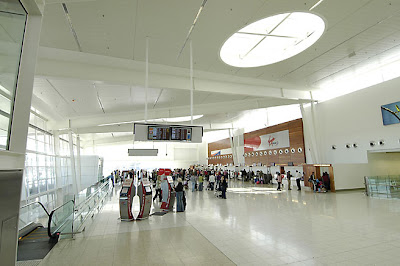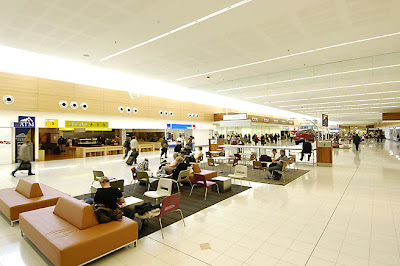airplane image by aaron kraten (awesome artist) stolen from his flickr set.
Following on from the discussions on art and transport i posted about here, i’ve been doing some investigating into the role of art and transport together. my current flavour of the month centres around airports.
i spent a lot of time in airports as a kid – i was an ID90 kid. that’s jargon for the child of an airline staff member. so it stands to reason that i have a fascination with airports and airplanes as public spaces and forms of transport.
The airport is a particular kind of public space: unlike loads of other transport hubs, it’s not entirely democratic, given that you have to pay a huge sum in order to facilitate being there. and for most of the space, you have to go through security searches. and that’s just the passenger terminals. it also contains huge sections of open, but incredibly restricted space: tarmac, hangars and runways.
but similar to other axes of transportation, it’s incredibly dynamic and diverse. and, depending on the airport, the sheer number of people passing through the space is unlike any other.
And yet, for all the coming and going, to-ing and fro-ing, there are also large numbers of people waiting around, trying to get comfortable, hungry, tired, bored, anxious, excited and joyous. and, like in the film Love Actually, airports are areas for expression of pure love. unlike most other public spaces connected to transport.
So, in terms of a marriage between airports and art, architecture and design, it’s a hell of a brief:
Make a site that’s got to have room for 500 people getting off a long-haul flight; space to run full-pelt towards your flight that’s about to close [but not so much that you scare the living daylights out of post-9/11 jittery security staff]. But it’s also got to have a cosy space to be able to curl up with a book while you’re waiting 3 hours for a connection, or for your loved one whose flight has been delayed.
Aesthetically, it has to appear clean, calm, safe and orderly to allay fears post 9/11 and also for those 80% of passengers who are afraid of flying, but at the same time, has to leave enough emotional space to accommodate the inevitable tears from hellos and goodbyes.
You need to do the basics in terms of logistics: cars, luggage, public transport, check-in, security and the official stuff. And of course, in terms of planning and business strategy, there have to be places to be basically human: food, water, toilets, prayer and entertainment.
And, naturally, flying changed dramatically after 9/11. Interestingly, though, I’ve noticed that, as a result, more care, thought and pointed strategy has gone into airports and airplanes since. Perhaps it’s because the airline industry stopped taking flying for granted and started to look at the benefits of flying and how to improve the experience of it. Or perhaps it’s always been like this, and i’m just noticing it now for the first time.
And seeing as I am noticing it, the whole world seems to be conspiring with me too!
Ben‘s been posting about his opinion of Heathrow’s new T5 and its new interactive signage and infographics; Design Quarterly has done a bit of a feature on Marc Newsom‘s design of the Qantas Lounge at Sydney Airport (above), and I picked up a cheap copy of last month’s Monocle mag, which was focusing on trains, but raised some of the same points about the experience of train travel vs air travel.
Then, over Easter, I went to Adelaide [boy has that airport changed in the last few years!] and I got to experience an airport that had obviously had a good long think about how to lay out the space, how to engage people, give them a good experience, while rushing them along to their planes. I took pictures even (and didn’t get arrested, which was nice). They even had art works on the walls and a showcase of maqettes from the JamFactory Furniture Design Studio.
Which reminded me about the secret desire I’ve had to open up a gallery in an airport. With all that amazing space, people looking for mental and visual stimulation, tourists looking to experience an essence of a place (and take some of that away with them), what better place to start an interesting art space. Or some site-specific projects.
And speaking of site-specific projets, one of my other secret desires has been to create an installation/experiential artwork within the interior of the plane. not to really freak anyone out, but to add a sense of play to the space which isn’t really there at the moment (aside from the chipper staff on Virgin flights). Does essential plane travel still have to be glum?
Having had that playing on my mind, it was with glee that I listened to a fabulous interview by The Architects on 3RRR featuring with Frederique Houssard-Andrieux, a designer who is working specifically with the interior of airplanes. I already love this woman! and one day would love to work with her – she spoke about colour use within the confined space of the cabin with real depth and understanding. and she’s looking to push the boundaries of what the fitouts of fleets will look like and feel like. unlike car upholstering, designing the interior of a passenger airplane (especially the long-haul jumbos she’s working on) really have to take into account the psychology and feelings of the passengers. and how there’s a whole range of pretty intense emotions that could feature in a flight, which need to be addressed in the design [and i suspect some of the fantastic primary school designers are probably tackling similar issues.]
Having said all that, airplanes and airports have always been aesthetically rich, thanks the need to try and make [expensive] air travel sexy and attractive. but since it has become mainstream and then back towards an environmental anathema, i think there is going to be a renaissance of design and interaction with this form of public transport. Which I have to confess, I’m a little bit excited about.



